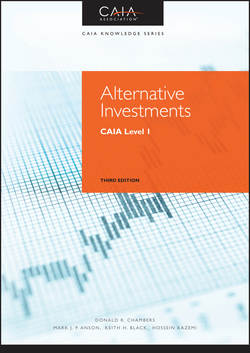Читать книгу Alternative Investments - Hossein Kazemi - Страница 48
На сайте Литреса книга снята с продажи.
PART One
Introduction to Alternative Investments
CHAPTER 3
Quantitative Foundations
3.4 Problems with Internal Rate of Return
3.4.5 Time-Weighted Returns versus Dollar-Weighted Returns
ОглавлениеThe purpose of this section is to provide details regarding time-weighted returns versus dollar-weighted returns. Briefly, time-weighted returns are averaged returns that assume that no cash was contributed or withdrawn during the averaging period, meaning after the initial investment. Dollar-weighted returns are averaged returns that are adjusted for and therefore reflect when cash has been contributed or withdrawn during the averaging period. The IRR is the primary method of computing a dollar-weighted return.
When evaluating the return of hedge funds, mutual funds, or any investment, it's important to recognize the distinction between the time-weighted return, which is similar to what is reported on performance charts in marketing literature and client letters, and the dollar-weighted return, which represents what the average investor actually earned; the two can be very different.
Suppose there is a hedge fund that in year 1 starts with $100 million of AUM (assets under management). Let's further suppose that the hedge fund generates an average annual return of 20 % for each of its first three years. With such a performance history, the hedge fund attracts quite a bit of new capital. Let's assume that the hedge fund attracts $200 million in new assets for year 4, another $200 million for year 5, and nothing in year 6. Unfortunately, the new capital does not help the hedge fund manager maintain the fund's stellar performance, and the manager earns 0 % in years 4, 5, and 6. If we use time-weighted returns over this six-year period, the hedge fund manager has an average annual return of 9.5 %:
In effect, the time-weighted return assumes that a single investment (e.g., $1) was made at the beginning of the period and was allowed to grow with positive returns and decline with negative returns until the end of the measurement period, with no cash withdrawals or additional contributions. The rate that equates the initial value with the accumulated value is the time-weighted average return, and it is somewhat near the arithmetic average annual return (in this case, 10 % per year). The idea is that a single sum of money invested at the start of the first year and allowed to remain in the fund until the end of the last year would accumulate to the same value as if it had been invested at a fixed return of 9.5 % per year, ignoring rounding.
But in practice, investors often contribute additional cash (i.e., make additional investments) or withdraw cash (e.g., liquidate part of the investment or receive cash distributions) during the time period under analysis. Their average returns depend on whether the amount of money invested was highest during the high-performing periods or during the low-performing periods. Dollar-weighted returns adjust the average annual performance for the amount of cash invested each year. In the case of the hedge fund, an investor who had much more cash in the fund in the early years than in the later years would earn more than an investor whose money was primarily invested in the last three years, when the fund generated 0 % returns.
Dollar-weighted returns can be computed for each investor using investors' cash flows into and out of the hedge fund. The total cash flows into and out of the fund for all investors can be used as an indication of the performance of an average investor. The dollar-weighted return that individual investors experience depends on their cash contributions and withdrawals.
When the timing of the aggregated cash flows for the entire hedge fund is taken into account, the bulk of the hedge fund's assets earned a 0 % return in years 4, 5, and 6. The example shows that only the first $100 million earned the great rates of return of the first three years. The $400 million that flowed into the hedge fund in years 4 and 5 earned a 0 % return. When the timing of the aggregated cash flows is taken into account, the dollar-weighted return (solving for the IRR with cash flows reinvested) is only 4.3 %. The IRR is found in this case with CF0 = –100, CF1 = 0, CF2 = 0, CF3 = –200, CF4 = –200, CF5 = 0, and CF6 = +572.8; that is, CF6 is found as: [(100 × 1.2 × 1.2 × 1.2) + 200 + 200].
Investment managers are best evaluated on time-weighted returns, as these managers should not be held accountable for the cash flow decisions of their investors. Investors should evaluate their own investment results using dollar-weighted returns based on the cash flows from their particular investment pattern.
